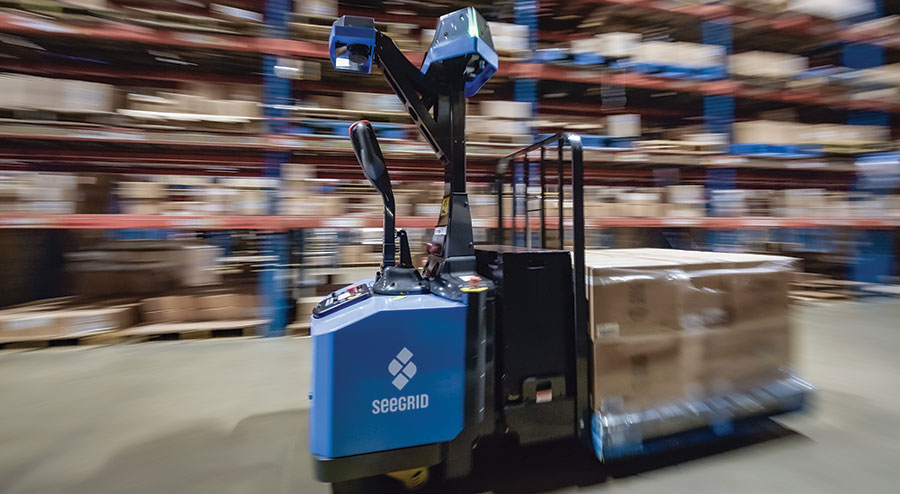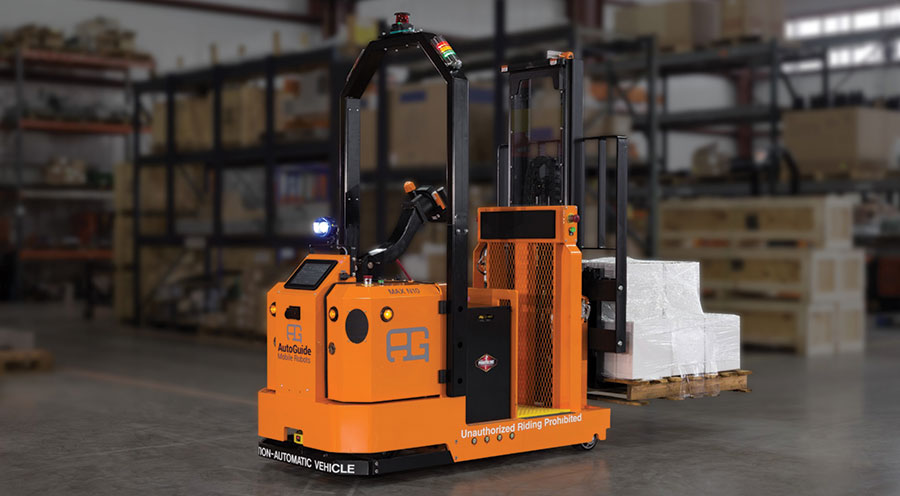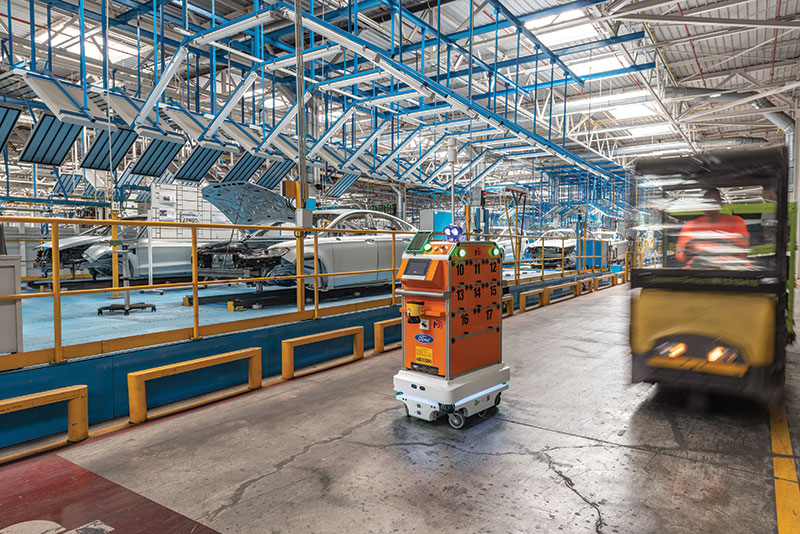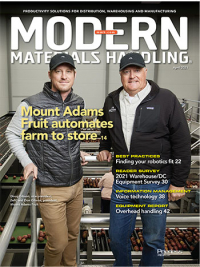Automotive builds a new path
Transportation of parts and assemblies in auto plants is taking on a new look with its increasing use of guided vehicles and carts as well as autonomous mobile robots. In a word, it’s all about flexibility.
While the past year hasn’t been normal for anyone, Covid has certainly left its mark on the auto industry.
First, sales fell roughly by half in the United States before making a bit of a comeback. But this year, the auto industry says that a Covid-induced chip shortage will shave $60 billion off worldwide sales.
Meanwhile, the Boston Consulting Group says sales in Europe and the United States “will not rebound to pre-Covid levels until 2023 at the earliest.”
At the same time, the industry is making plans for future production of electric vehicles (EV) in large quantities. It’s clear that EVs require far fewer parts than internal combustion engine cars, and they can be built with about 60% of the labor hours. That will require a new approach to building vehicles.
That’s a lot of change in a short period of time. And all this change is in a far different world than the model changeovers that automakers are used to tightly controlling and managing.
Which raises an interesting question: How is the auto industry coping with the transportation of parts and assemblies inside the four walls of its top suppliers and at the automakers themselves? In a few words—not badly, at all. And after talking to experts here, that’s actually not surprising.
Quite simply (and if you’ll excuse an overused, but applicable phrase), the auto industry has lots of tools in its tool box. Those tools range from very traditional chain and friction-drive conveyors to automatic guided vehicles (AGVs) and carts (AGCs) and now autonomous mobile robots (AMRs). How each gets used is very much a work in progress.
“We’re in a time when automated materials flow is becoming the focal point,” explains Jeff Christensen, vice president of product at Seegrid. “Automakers aren’t trying a big bang approach to make improvements here, but are focused on continuous improvement. And it all centers on the combination of automation and software that drives and measures automation to continuously improve,” he adds.
The power of automation
Interestingly, the recurring word here is flexibility. Yes, flexibility. Not something auto production is known for traditionally. As you might imagine, flexibility comes in different forms.
In some cases, it’s a matter of more workflow options. In other cases, it’s a matter of less labor. And in more and more cases, the two are happening simultaneously.
“The more flexibility there is in auto plants, the more everything and everyone is helped,” explains David Musch, a regional manager at Bastian Solutions.

Increased workflow options combined with decreased labor requirements are the story behind the advancement of automated transportation in auto plants.
What happened recently at GECOM Corp. is a good example. The auto parts supplier’s Greensburg, Ind., plant needed to improve lineside delivery of empty pallets and tubs as well as takeaway of finished goods. The target was to eliminate the need for tuggers, carts and pallet jacks driven by people.
Now, five pallet handling AGVs from F-3 Design (Nipper) get the job done, says Steven Lockhart, senior design industrial engineer. They eliminated 73% of the labor hours previously required for those operations while improving the movement of parts, he explains.
In fact, the AGVs have all the workflow flexibility possible. They are guided by a next-generation navigation system similar to those used by AMRs. This eliminates the need for fixed magnetic tape or laser guidance systems traditionally used by AGVs in auto plants. Instead, these five vehicles follow a digital map of the plant and rely on a natural feature navigation system that guides vehicles on demand from narrow, 8-foot-wide aisles to the line and back. It’s all under a centralized supervisory control and data acquisition system.
“It’s definitely been a successful project,” adds Lockhart. “We’ve made our target headcount reduction, delivered a two-year ROI and are exploring other AGV possibilities.” (For complete details, see Modern’s October 2020 issue, p. 18.)
ROI in particular is an interesting point here. As Mike Noll of St. Onge explains, ROI continues to be important in equipment buying decisions, but its relative importance overall has shifted. “Go back just a couple of years, and ROI was 90% of the discussion,” he says. “But now it only accounts for 20% with other benefits ranging from operational efficiencies and flexibility being the other 80%.”
That shift alone offers a key insight into how the automation equation has evolved when it comes to moving parts and assemblies in auto plants.
Shifts in transportation modes
That said, GECOM is far from alone in exploring automation possibilities.
“In the last six months, there have been more requests for AGV and AGC systems than in the past two years,” says Kelsey Schell, senior sales manager at Daifuku America.
At the same time, Schell points out, that doesn’t mean parts and assembly transportation in automotive is being overrun by AGVs and AGCs. Or AMRs, for that matter. It’s all gradual.

AGVs with mobile robot navigation systems maximize flexibility on the production floor.
Chain conveyor, including power and free, as well as friction-drive conveyors using skillets and skids still dominate paint shops and assembly lines. Schell doesn’t see that changing anytime soon.
The shift already in motion is the move to lineside delivery of parts and takeaway of assemblies with AGVs, AGCs and AMRs. But even those transportation modes account for less than 20% of all transport materials handling equipment in place today, says Schell.
Yes, manned lift trucks, pallet jacks and tuggers continue to be widely used. Just ask Lockhart of GECOM. But the push is to minimize them whenever possible.
As Musch of Bastian explains, key points are in the decision-making process here. One is the size of the load and the ability of the equipment to easily handle loads repetitively and safely within the facility’s existing footprint. Another is the ability of the facility’s sequencing and communication system to direct unmanned vehicles. A third is the maintenance team. More precisely, how familiar are they with the technology before it is even purchased.
The top three activities on the production floor getting attention, according to Seegrid’s Christensen, are: sequenced pickups in the dock area; pickups from lift tables and conveyors; and, finally, hand-offs to tuggers.
One example of transportation shifts underway today is the parts supermarket area, explains Creform’s vice president of sales Keith Soderlund. This is where most if not all kits are built for the assembly line. Not only do these kits have to be right, they also have to be brought to the line in the right sequence with high efficiency.
That’s where AGVs and AGCs, says Soderlund, are increasingly gaining dominance as the preferred transportation mode. Typically, it’s a 300- to 500-foot loop from the supermarket to the line and back. Full kits go to the line and empty ones return to the supermarket. “Each vehicle’s predictable speed, reliability and safety combine to make this application ideal for automated kits movement,” adds Soderlund.
While AGVs have been on the floor for decades, AMRs are the most recent addition, points out Josh Cloer, sales director for the Eastern United States at MiR. Mobile robots come in many shapes and sizes, and can be deployed quickly.
Typically, mobile robots bring subcomponents to the line using variations on the navigation technology at GECOM. This allows them to operate autonomously while ensuring workers are safe. It’s common for fixtures to be built on top of an AMR, making it a mobile workstation in addition to being a mode of transportation for parts.
Cloer says AMRs are still early in the adoption curve, but they are working alongside AGVs, AGCs, tuggers and even lift trucks.
And, yes, lift trucks are still out on the floors of auto plants, but they are increasingly joined by AGVs. “The fork free movement is still ongoing,” says John Rosenberger, Raymond’s director of iWarehouse gateway and global telematics. That has helped to promote the use of automated tuggers and tow tractors, especially for long hauls on the shop floor. Raymond’s latest entry here is a vision-guided automated tow tractor capable of moving 15,000 pounds.
Meanwhile, Seegrid recently introduced a fork-based AMR for the movement and placement of palletized goods. The vision-guided vehicle can lift loads as high as 6 feet above the floor for point-to-point task automation. The fork-free movement will continue, just with manual fork vehicles.
The shift to EVs
If all of this is not enough change for automotive, the move to EVs is going to create even more.
In fact, this is where Rob Sullivan, president and CEO of AutoGuide Mobile Robots, sees the strongest move to automated or autonomous transportation modes going forward.
“EV production is going to put a premium on flexibility. Manufacturers will want to change work cells more frequently and will want to move away from fixed assets including fixed transportation systems,” says Sullivan. That will put a premium on AGVs with mobile robot navigation systems, he adds.
Musch of Bastian echoes those thoughts. He expects that the current centralized parts supermarket concept will change considerably. He foresees a move to what he calls micro-fulfillment of parts. Centralized supply will disappear with EVs, he says, with parts fulfillment managed from many locally placed locations dedicated to a small number of parts rather than many. That, in turn, he expects will require even greater flexibility and responsiveness of AMRs to keep the assembly line moving.
As Christensen of Seegrid recently said, “if you stay in the same spot in the river, the river will run right past you, and you will become stagnant.” And that seems to be exactly what the auto industry is most trying to avoid when it comes to transportation of parts in its plants.

Article Topics
AGVs and AMRs News & Resources
2024 Intralogistics Robotics Survey: Robot demand surges Autonomous mobile robots (AMRs) on a mission K.Hartwall and its Australian distribution partner, Retailquip, join forces Pramac partners with BlueBotics to launch line of ANT driven mobile robots Mitsubishi Logisnext partners with Jungheinrich to introduce Rocrich AGV Solutions CaPow’s power-in-motion solution eliminates charging downtime Conveyco unveils All-Temp AMRs that can move between frozen, chilled and ambient warehouses More AGVs and AMRsLatest in Materials Handling
Geek+ and System Teknik deploy PopPick solution for pharmacy group Med24.dk Beckhoff USA opens new office in Austin, Texas Manhattan Associates selects TeamViewer as partner for warehouse vision picking ASME Foundation wins grant for technical workforce development The (Not So) Secret Weapons: How Key Cabinets and Asset Management Lockers Are Changing Supply Chain Operations MODEX C-Suite Interview with Harold Vanasse: The perfect blend of automation and sustainability Consultant and industry leader John M. Hill passes on at age 86 More Materials HandlingAbout the Author
Subscribe to Materials Handling Magazine

Find out what the world's most innovative companies are doing to improve productivity in their plants and distribution centers.
Start your FREE subscription today.
April 2024 Modern Materials Handling

Latest Resources












